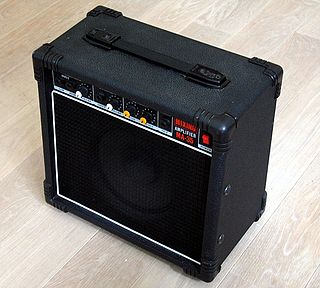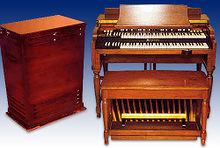
The Hammond organ is an electric organ invented by Laurens Hammond and John M. Hanert and first manufactured in 1935. Multiple models have been produced, most of which use sliding drawbars to vary sounds. Until 1975, Hammond organs generated sound by creating an electric current from rotating a metal tonewheel near an electromagnetic pickup, and then strengthening the signal with an amplifier to drive a speaker cabinet. The organ is commonly used with the Leslie speaker.

In music, the organ is a keyboard instrument of one or more pipe divisions or other means for producing tones. The organs have usually two or three, up to five, manuals for playing with the hands and a pedalboard for playing with the feet. With the use of registers, several groups of pipes can be connected to one manual.

An electronic keyboard, portable keyboard, or digital keyboard is an electronic musical instrument based on keyboard instruments. Electronic keyboards include synthesizers, digital pianos, stage pianos, electronic organs and digital audio workstations. In technical terms, an electronic keyboard is a rompler-based synthesizer with a low-wattage power amplifier and small loudspeakers.

A tonewheel or tone wheel is a simple electromechanical apparatus used for generating electric musical notes in electromechanical organ instruments such as the Hammond organ and in telephony to generate audible signals such as ringing tone. It was developed by Thaddeus Cahill for the telharmonium c. 1896 and patented in 1897. It was reinvented around 1910 by Rudolph Goldschmidt for use in pre–vacuum-tube radio receivers as a beat frequency oscillator (BFO) to make continuous wave radiotelegraphy signals audible.
Farfisa is a manufacturer of electronics based in Osimo, Italy, founded in 1946. The company manufactured a series of compact electronic organs in the 1960s and 1970s, including the Compact, FAST, Professional and VIP ranges, and later, a series of other keyboard instruments. They were used by a number of popular musicians, including Sam the Sham, Country Joe and the Fish, Pink Floyd, Sly Stone, Blondie, Suicide and the B-52s.

An electric organ, also known as electronic organ, is an electronic keyboard instrument which was derived from the harmonium, pipe organ and theatre organ. Originally designed to imitate their sound, or orchestral sounds, it has since developed into several types of instruments:

A sound module is an electronic musical instrument without a human-playable interface such as a piano-style musical keyboard. Sound modules have to be operated using an externally connected device, which is often a MIDI controller, of which the most common type is the musical keyboard. Another common way of controlling a sound module is through a sequencer, which is computer hardware or software designed to record and playback control information for sound-generating hardware. Connections between sound modules, controllers, and sequencers are generally made with MIDI, which is a standardized interface designed for this purpose.

The Nord Electro is a series of electronic keyboards, developed in Sweden by Clavia, that digitally emulate electro-mechanical keyboards, such as electric pianos and electronic organs, while designed to be highly portable.

Ace Electronic Industries Inc., or Ace Tone, was a manufacturer of electronic musical instruments, including electronic organs, analogue drum machines, and electronic drums, as well as amplifiers and effects pedals. Founded in 1960 by Ikutaro Kakehashi with an investment by Sakata Shokai, Ace Tone can be considered an early incarnation of the Roland Corporation, which was also founded by Kakehashi. Ace Tone began manufacturing amplifiers in 1963.
The Nord Stage is a digital keyboard or stage piano, manufactured by Clavia Digital Music Instruments of Stockholm, Sweden. There have been six editions of the instrument: the original Nord Stage in 2005, the Nord Stage EX in 2008, the Nord Stage 2 in 2011, the Nord Stage 2 EX in 2015, the Nord Stage 3 in 2017, and the Nord Stage 4 in 2023.

The Vox Continental is a transistorised combo organ that was manufactured between 1962 and 1971 by the British musical equipment manufacturer Vox. It was designed for touring musicians and as an alternative to the heavy Hammond organ. It supports drawbars in a similar manner to the Hammond, and has distinctive reverse-coloured keys. The sound is generated by a series of oscillators, using a frequency divider to span multiple octaves.
A combo organ, so-named and classified by popular culture due to its original intended use by small, touring jazz, pop and dance groups known as "combo bands", as well as some models having "Combo" as part of their brand or model names, is an electronic organ of the frequency divider type, generally produced between the early 1960s and the late 1970s. This type of organ predated, and contributed largely to, the development of modern synthesizers. The combo organ concept, at least in the context of mass-production, is thought to have arisen from popular demand, when smaller home organs were seen in music stores. Combo organs were probably originally developed in the United Kingdom, based on the Univox polyphonic version of the Clavioline, and some models included the inner-workings of Italian-made transistor accordions. They were the brainchild of necessity for portable organs of simple design, mainly for use in these small groups. Combo organs ended up having a major impact on the music scene of the mid- and late 1960s, particularly on rock and roll of that era.

The Roland VK-7 is an electronic keyboard introduced in 1997 which simulates the sound of an electromechanical Hammond organ. Like other electronic musical instruments that emulate the sound of the electromechanical tonewheel-based organs formerly manufactured by Hammond, the VK-7 is referred to as a clonewheel organ. Currently it is replaced by the VK-8 and the VK-88.

A keyboard amplifier is a powered electronic amplifier and loudspeaker in a speaker cabinet used for the amplification of electronic keyboard instruments. Keyboard amplifiers are distinct from other types of amplification systems such as guitar amplifiers due to the particular challenges associated with making keyboards sound louder on stage; namely, to provide solid low-frequency sound reproduction for the deep basslines that keyboards can play and crisp high-frequency sound for the high-register notes. Another difference between keyboard amplifiers and guitar/bass amplifiers is that keyboard amps are usually designed with a relatively flat frequency response and low distortion. In contrast, many guitar and bass amp designers purposely make their amplifiers modify the frequency response, typically to "roll-off" very high frequencies, and most rock and blues guitar amps, and since the 1980s and 1990s, even many bass amps are designed to add distortion or overdrive to the instrument tone.
The Korg CX-3 is an electronic clonewheel organ with drawbars that simulates the sound of an electromechanical Hammond organ and the Leslie speaker, a rotating speaker effect unit. The CX-3 was first introduced in 1979.

Diversi Musical Products, Inc is a manufacturer of electric organs. It specializes in making clones of the Hammond organ and became popular when jazz organists "Papa" John and Joey DeFrancesco "defected" from Hammond to using their organs instead.

Electric music technology refers to musical instruments and recording devices that use electrical circuits, which are often combined with mechanical technologies. Examples of electric musical instruments include the electro-mechanical electric piano, the electric guitar, the electro-mechanical Hammond organ and the electric bass. All of these electric instruments do not produce a sound that is audible by the performer or audience in a performance setting unless they are connected to instrument amplifiers and loudspeaker cabinets, which made them sound loud enough for performers and the audience to hear. Amplifiers and loudspeakers are separate from the instrument in the case of the electric guitar, electric bass and some electric organs and most electric pianos. Some electric organs and electric pianos include the amplifier and speaker cabinet within the main housing for the instrument.
The history of home keyboards lies in mechanical musical instrument keyboards, electrified keyboards and 1960s and 1970s synthesizer technologies.
The VK-8 Combo Organ is a discontinued electronic keyboard introduced in 2002, which simulates the sound of an electromechanical tonewheel-based Hammond organ. The VK-8 is both an improvement and successor to both the VK-7 and VK-77. The VK-8 itself was succeeded by the VK-88.



























